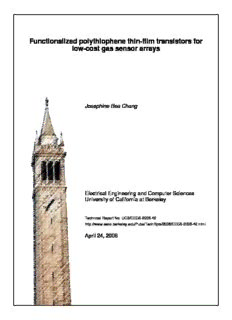
Functionalized polythiophene thin-film transistors for low-cost gas sensor arrays PDF
Preview Functionalized polythiophene thin-film transistors for low-cost gas sensor arrays
Functionalized polythiophene thin-film transistors for low-cost gas sensor arrays Josephine Bea Chang Electrical Engineering and Computer Sciences University of California at Berkeley Technical Report No. UCB/EECS-2006-42 http://www.eecs.berkeley.edu/Pubs/TechRpts/2006/EECS-2006-42.html April 24, 2006 Copyright © 2006, by the author(s). All rights reserved. Permission to make digital or hard copies of all or part of this work for personal or classroom use is granted without fee provided that copies are not made or distributed for profit or commercial advantage and that copies bear this notice and the full citation on the first page. To copy otherwise, to republish, to post on servers or to redistribute to lists, requires prior specific permission. FUNCTIONALIZED POLYTHIOPHENE THIN- FILM TRANSISTORS FOR LOW-COST GAS SENSOR ARRAYS by Josephine Bea Chang B.S. (University of Texas, Austin) 2001 M.S. (University of California, Berkeley) 2004 A dissertation submitted in partial fulfillment of the requirements for the degree of Doctor of Philosophy in Engineering-Electrical Engineering and Computer Sciences in the GRADUATE DIVISION of the UNIVERSITY OF CALIFORNIA, BERKELEY Committee in charge: Professor Vivek Subramanian, Chair Professor Chenming Hu Professor Don Tilley Spring 2006 FUNCTIONALIZED POLYTHIOPHENE THIN- FILM TRANSISTORS FOR LOW-COST GAS SENSOR ARRAYS © Copyright 2006 by Josephine Bea Chang The dissertation of Josephine Bea Chang is approved: Chair Date Date Date University of California, Berkeley Spring 2006 ABSTRACT FUNCTIONALIZED POLYTHIOPHENE THIN-FILM TRANSISTORS FOR LOW-COST GAS SENSOR ARRAYS by Josephine B. Chang Doctor of Philosophy in Electrical Engineering and Computer Sciences University of California, Berkeley Professor Vivek Subramanian, Chair A low-cost electronic nose solution based on printed arrays of organic thin film transistor gas sensors is proposed. First, polythiophene organic thin film transistors are shown to be suitable for use as gas sensors. Good sensitivity to a range of gas analytes including alcohols, thiols, amines, and acids is observed down to 10 ppm. The alcohol and acid response is also reversible at low concentrations. Then, a synthetic route is demonstrated for predictably altering sensor response through the incorporation of functionalized end-capping groups. This route is used to generate an array of polythiophene sensor inks with differentiated sensor response, and effect of end-group functionality and placement are investigated. An integrated gas sensor array is fabricated using a droplet-on-demand technique as a demonstration of the possibility for low-cost manufacturing. Finally, the design of organic-based logic support circuitry for the sensor array is considered. 1 ACKNOWLEDGMENTS This work has been the recipient of a generous input of time and effort from many people at Cal. Dr. Jean Fréchet’s research group in the Chemistry department was an invaluable source of ideas, chemical expertise, and, most importantly, in-house synthesized materials. In particular, I would like to thank Kevin Sivula and Amanda Murphy for many useful discussions and a fruitful collaboration over the years. In my own lab group, Vincent Liu’s contributions to this research are much appreciated, and Jason Lee was an invaluable resource for the device modeling and circuit simulation portion of the work. Thanks also to Steve Volkman, who was always there when I needed advice, and to Alejandro de la Fuente, for making our lab a bearable place to work. In addition, Frank Liao must be acknowledged as the true founder of this sensors project. He developed a flexible, robust experimental infrastructure that I had the good fortune to inherit. And, of course, I’ve been incredibly lucky to have had the privilege of working with Vivek Subramanian, my advisor, mentor, and role model over the past four years. Thanks, Vivek, for making my graduate school productive, rewarding, memorable, and fun. Thank you most of all for football and for Paul. i Dedicated to my mom and dad, who have always given me only the best, and have hoped for this even longer and harder than I have. ii TABLE OF CONTENTS CHAPTER 1: INTRODUCTION..............................................................................................1 CHAPTER 2: BACKGROUND ON ELECTRONIC NOSES...............................................6 2.1 HISTORICAL DEVELOPMENT................................................................................................7 2.2 BIOLOGICAL NOSES..............................................................................................................9 2.3 GAS HANDLING AND DELIVERY........................................................................................11 2.4 GAS SENSING ELEMENTS....................................................................................................12 2.4.1 Metal-oxide sensors.............................................................................................................13 2.4.2 Conducting polymer sensors...................................................................................................15 2.4.3 Polymer composite sensors......................................................................................................17 2.4.4 MOSFET sensors..............................................................................................................19 2.4.5 Gravimetric sensors..............................................................................................................20 2.5 DATA ANALYSIS..................................................................................................................20 2.5.1 Nearest neighbor method.......................................................................................................21 2.5.2 Statistical analysis techniques.................................................................................................21 2.5.3 Artificial neural network......................................................................................................23 2.6 CURRENT APPLICATIONS OF ELECTRONIC NOSES.............................................................23 2.7 REFERENCES.......................................................................................................................25 CHAPTER 3: BACKGROUND ON ORGANIC ELECTRONICS.....................................26 3.1 HISTORICAL DEVELOPMENT..............................................................................................27 3.2 ELECTRICAL CHARACTERISTICS OF CONJUGATED OLIGOMERS AND POLYMERS..............28 3.3 ORGANIC THIN FILM TRANSISTORS (OTFTS).....................................................................33 3.3.1 Device structure and fabrication..............................................................................................33 3.3.2 Current-voltage characteristics................................................................................................36 3.3.3 Field-effect mobility..............................................................................................................38 3.3.4 Turn-on characteristics.........................................................................................................41 3.4 APPLICATIONS OF OTFTS..................................................................................................46 3.4.1 Displays............................................................................................................................46 3.4.2 Radio frequency tag identification (RFID)...............................................................................48 3.5 REFERENCES.......................................................................................................................49 CHAPTER 4: LIFETIME AND RELIABILITY....................................................................50 4.1 CAUSES OF SIGNAL DRIFT...................................................................................................51 4.1.1 Bias stress effect...................................................................................................................51 4.1.2 Sensor response to oxygen and humidity...................................................................................53 4.1.3 Material Degradation..........................................................................................................55 4.2 EXPERIMENTAL SETUP.......................................................................................................56 4.3 RESULTS..............................................................................................................................59 4.3.1 Active layer material dependence.............................................................................................60 4.3.2 Active layer thickness dependence............................................................................................61 4.4 DEALING WITH BIAS STRESS...............................................................................................70 4.4.1 Pulsed operation..................................................................................................................70 iii
Description: